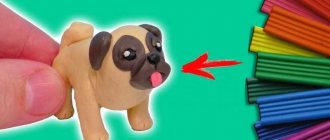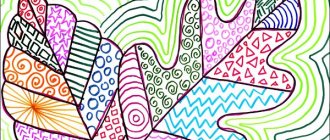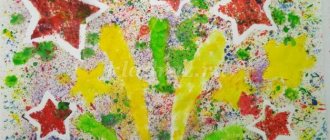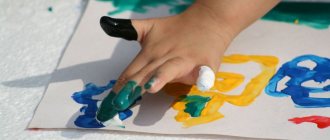Autumn motifs in the works of children
You can make working on a craft interesting for children if you take into account their capabilities. Therefore, I will try to show the works according to age level. I'll start with our work. For the tree, I rolled plasticine balls, and my son flattened it and drew a pattern on the leaves with a knife.
View this post on Instagram
Inspired by the bright fish, we made another picture of the autumn Dnieper from plasticine. We also printed out a coloring book and painted for about an hour. fingers trained. All our games and activities #daynotes_play #what to play with a child #what to do with a child #developmental #crafts with children #modeling from plasticine #modeling with children #drawing for children #painting from plasticinePublication from Elena Selivanova (@daynotes.ru) Oct 12, 2021 at 10:10 PDT
Vegetables fruits
3-year-old child can easily handle kneading plasticine. No matter how he does it, the resulting figurine can be recognized as a carrot or tomato, cucumber, pear, etc. What will the little one create? Ideas will appear on their own, looking at the color of the product and its shape. A couple of additional touches, and the naturalness of the design cannot be disputed!
Pumpkin
Carrot
Apple and pear
Basket with vegetables
Author of works on Instagram
Caterpillar
But a caterpillar is several circles gathered together and attached one after the other. To give strength to the structure, place all individual fragments on a toothpick. And, if you want the caterpillar to be flexible, put the balls on a needle and pull it along the thread. When all the parts are assembled, cut the thread at the needle itself, and embed its tip in plasticine.
You can, as this master class , make a caterpillar rainbow.
And don’t forget about the design of the face and the paws! By the way, here the circles are simply attached to each other. And this option is also suitable.
Painting-applique “Autumn in the forest”
Older children want to show their talent more fully. For example, preparatory group in a kindergarten can start making a real autumn meadow, where mushrooms grow and animals run around.
This is the kind of application we will make too.
- In the middle of the leaf we make a tree trunk. We select the shape and color. For example, birch can be white and slightly curved.
- Branches extend from the trunk.
- To make our tree more like a birch tree, we make “spots” by pressing holes (not through holes) with a small object.
- You can complement the picture with several black spots.
- We tear off the “leaves” from the yellow plasticine and glue them around the branches.
- It's autumn, which means there are also a lot of fallen leaves on the ground.
- Mushrooms grow around. They have a semicircular cap and short legs.
- There is a Christmas tree next to the birch tree. Glue a semicircle at the bottom. We divide this “skirt” into strips with a special knife. And so on for each top ball.
- There must be a hedgehog near the mushrooms. It is made like a droplet, only the nose is slightly turned up.
- Separate the part where the hedgehog has needles and draw many, many stripes.
- The hedgehog is already with the harvest. Glue a small fungus onto its needles.
- The bunny is standing by the Christmas tree. It has a head with long ears, a body, legs and a tail.
- Autumn heavy clouds and flying birds complete the picture.
- Author of the master class
Of course, if it is difficult for the baby to do something from this, you can skip this detail.
Painting "Autumn"
Such a picture can be done by children from 3 years old, however, if the child is assiduous. But 4-5 year olds can easily cope with this task.
Of course, it will be much easier if mom helps roll the balls.
Author on Instagram
More painting ideas from the Internet
Pictures enlarge by click
Sensory box "Autumn".
Surely your baby will be interested in a sensory box with the theme “Autumn”.
We got something like this, for example:
How to play with the box:
The box can be used to “play” various “autumn” scenes:
“The bunny collects leaves”, “The squirrel is looking for nuts”, “The leaves rustle underfoot.”
It will be interesting for the baby to watch how his mother acts out different scenes (“mini-fairy tales”) using this box, at the same time he will very quickly learn all the “autumn” words.
In addition, many children will enjoy fiddling around in such a box on their own.
Plasticine and natural materials
Snail
For 4-year-old it is not difficult to cope with such a small structure.
- Roll out the plasticine into oblong droplets.
- On one edge of the “droplet”, which is thicker, use a needle or thin stick to draw a smile and eyes. This is the head. Make tendrils from small twigs on top of it.
- Place the blank on the leaf and glue it.
- Place a walnut or chestnut on top.
If such crafts are made in kindergarten , then it is advisable to prepare natural materials in advance. Clean it and show the little one what can be built from it.
Hedgehog
For a 5-year-old it will not be difficult to make such a design.
- Its main part is the plasticine body (wide part) and the head (narrow part) of the hedgehog.
- On the head we make a nose and eyes.
- We insert seed needles into the wide part.
Full information will be in the video .
Butterfly
Our baby is entering 1st grade , and it’s time to set more complex and interesting tasks for him. For example, this!
- You only need to sculpt 3 separate fragments and connect them. These parts resemble a snowman. The same principle: a small part, a larger part and a larger part.
- The main task is to lay out the leaves like a fan, or rather, two fans turned in different directions. These are butterfly wings.
- It would be correct to do this on a plasticine backing. Secure each individual leaf with plasticine to the previous ones.
- And place our 3 fragments on top in the middle.
At 6-7 years old, a child can easily cope with the choice of colors and shape of wings.
Modeling is a type of creativity that can be drawing, modeling, and design. The main thing is freedom and imagination.
Allow your little ones to fantasize and they will make wonderful crafts! And then you can show us off these works!
Be sure to take a look at the articles where we made flowers from leaves, paintings, and other crafts! Better yet, subscribe and then replenish your library with the most useful articles that will help your baby develop!
Plasticineography Autumn for primary school children. Master class with step-by-step photos
DIY plasticine painting. Master class: Autumn palette
Target audience: children 6-9 years old
Purpose: making a painting as a gift
The purpose of the master class: to perform decorative and applied work using the “Plasticine painting” technique.
Tasks:
Learn:
Learn new techniques for working with plasticine (pressing, smearing, etc.)
Develop:
- Develop the emotional sphere, creative thinking, imagination and fantasy.
- Develop fine motor skills.
Educational:
To foster independence, creativity, and aesthetic feelings in children.
Plasticineography is classified as an unconventional art technique; it involves drawing with plasticine on cardboard or any other dense base. The background and characters are depicted not by drawing, but by sculpting, while objects can be more or less convex, semi-volume. Working with plasticine helps the child express emotions, his vision of the world around him and his attitude towards it, form aesthetic taste, develop flexibility, coordination, fine motor skills of the fingers (which in turn contributes to speech development).
The child gradually learns perseverance, patience, accuracy, and the ability to always complete work. When working with plasticine, it is necessary to take into account its properties: softness, plasticity, adhesiveness, ability to soften under the influence of heat, fragility, ability to retain its given shape, water resistance.
Reminder when working with plasticine:
- For the base, it is necessary to use thick cardboard so that it does not deform when performing techniques of pressing, smearing, smoothing, and flattening.
- To work with a three-dimensional form, stacks are needed to highlight the characteristic features of a decorative object. 3. Working with plasticine is labor-intensive and requires effort, so in the process of doing it, children need rest in the form of thematic physical education minutes and warm-ups. 4. There must be a damp cloth for hands on the child’s desk so that he can use it at any time, and after completing the work, first wipe his hands with the napkin, and then wash his hands with soap and water.
Plasticineography develops children's creativity (primarily visual) - after all, with the help of this technique you can create an original, unique image with vivid expressiveness.
Master Class
Early autumn is the most wonderful time of the year! That is why many artists and poets tried to glorify its beauty in their works. We, inspired by the variety of autumn colors, will also create our own picture, which will resemble the artist’s palette. For work we will need the following tools and materials: 1. Plasticine 2. Stacks 3. Thick cardboard 4. Simple pencil 5. Paper napkin
Before starting work, use light strokes to sketch the intended design on thick cardboard with minimal elaboration.
Let's start working with the long shot. We paint the forest using green paint in two shades - light and dark. To do this, apply strokes with your fingers. We use pressing and smearing techniques.
Let's move on to the image of the forest in the foreground. For this we need green and yellow plasticine. To obtain the desired yellow-green shade, we use the technique of infusing one color into another. To do this, we use two methods. The first is to mix the plasticine directly on the base, applying strokes alternately. Second - we take several pieces of plasticine of different colors, knead them, mix them in one ball and draw.
In order to highlight the colors of the autumn forest, we selectively add orange using the same technique.
To draw houses, we take white, red and black plasticine. The roofs of the houses will be as bright as the foliage of the trees. Using black we will emphasize the shape of the houses and give clarity to the contours. To indicate the shadow we use blue and dark gray colors.
Let's draw a road. To depict it, we need a smooth texture of strokes. We use the smoothing technique. We use the following colors: yellow, brown, orange.
On the left and right we paint the ground with yellow and green. To do this, we again use the technique of pouring one color into another. We place the strokes in a certain direction. To emphasize the relief of the earth, highlands and lowlands, we add dark green color in some places.
To fill the sky we use white and blue plasticine. First, cover the entire area with light blue. To make it, you need to mix white and blue plasticine into one ball. Then selectively add dark blue color, smearing it in a circular motion, giving shape to the airy clouds.
Let's move on to a more detailed study of the picture. We return to the forest. To show the structure of tree foliage, it is necessary to make the texture more prominent. To do this, we use stacks to add various strokes and curves. In the right places we add the required color of plasticine, using the techniques of pinching, flattening, pulling and smearing. To add depth to the crown, add black color. We also use a dark color to indicate the shadow of the trees.
Let's draw grass in the foreground. We will need green plasticine in different shades. To depict grass we will use the rolling technique and the slapping technique. On the left is the shadow side, therefore the grass will be darker. On the right is the sunny side, which means that for the grass we use a color that is a shade lighter. Then we apply highlights with white plasticine; to emphasize the autumn season, we add yellow strokes here and there. Use a stack to shape the grass. The picture is ready. The autumn forest, playing with colors, Weaves wreaths from the crowns of trees, Pampering warm days with its sunny caresses. Close-up of the sky.
Close-up of houses.
Close-up of the road.
The technique of drawing with plasticine is fascinating not only for children, but also for adults. Creativity should bring the joy of communication, knowledge, work and relaxation. I wish you creative success!




